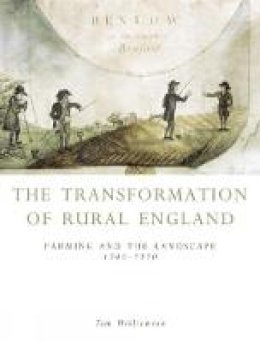
Stock image for illustration purposes only - book cover, edition or condition may vary.
The Transformation of Rural England: Farming and the Landscape 1700-1870 (History)
Tom Williamson
€ 48.75
FREE Delivery in Ireland
Description for The Transformation of Rural England: Farming and the Landscape 1700-1870 (History)
Paperback. Presents a study in detail of the making of the rural English landscape in the eighteenth and nineteenth centuries. This book approaches the debate from a direction: that of landscape archaeology. It argues that there was not one 'agricultural revolution' but many. Num Pages: 210 pages, 20 halftones and 20 line drawings. BIC Classification: 1DBK; HBJD1; HBLL; HDP; WMD. Category: (P) Professional & Vocational; (UP) Postgraduate, Research & Scholarly; (UU) Undergraduate. Dimension: 243 x 189 x 13. Weight in Grams: 596.
This is the first book to study in detail the making of the rural English landscape in the eighteenth and nineteenth centuries. For decades historians have debated the nature, timing and even the existence of the 'agricultural revolution'. This book approaches the debate from a new direction: that of landscape archaeology. It argues that there was not one 'agricultural revolution' but many. The enclosure of open fields and the reclamation of heath and downland - spearheaded by aristocratic improvers and large capitalist farmers - mesmerised contemporaries. But most enclosures had little to do with the improvement of arable farming, large landowners played a minor role and the really revolutionary changes took place elsewhere, in parts of England which were not characterised by large estates, and were the work of tenant farmers rather than landowners.
Product Details
Publisher
Liverpool University Press
Format
Paperback
Publication date
2002
Condition
New
Weight
595g
Number of Pages
210
Place of Publication
, United Kingdom
ISBN
9780859896344
SKU
V9780859896344
Shipping Time
Usually ships in 7 to 11 working days
Ref
99-50
About Tom Williamson
Tom Williamson is lecturer in landscape history at the University of East Anglia and has written widely on agricultural history, landscape archaeology and the history of garden design.
Reviews for The Transformation of Rural England: Farming and the Landscape 1700-1870 (History)
Williamson is well known for his landscape histories... In The Transformation of Rural England he not only makes good use of his own primary research, but he includes an impressive variety of secondary sources. This makes for a superior reference work, introduction to the topic, and scholarly contribution.... Few historians could pull off a comprehensive survey of he agricultural revolution in England, and Tom Williamson is one of them. Matt Osborn This is a thought-provoking book, pleasing but teasing ... [a] stimulating book. Rural History, Vol. 14, No. 2 This is a thoughtful and well-written book, which I can recommend wholeheartedly both to the amateur historian seeking background knowledge for a local study and to the professional looking for an authoritative survey of the existing literature. ... All will find stimulation in this book, not least from Williamson's own views and interpretations even if, at times, they may wish to challenge them. Journal of Southern History and Society Williamson marshals a wide range of evidence and presents it to good effect. Journal of Southern History and Society What is presented here is a well-balanced coverage of all the country. He argues persuasively for a series of agricultural revolutions. Journal of Southern History and Society ... one of the most important contributions of this book is the stress which Williamson lays on the regional variations which occurred. Journal of Southern History and Society ... he goes well beyond any narrow academic boundaries in his coverage. Journal of Southern History and Society This book offers a very wide-ranging and authoritative overview of the changes in rural England over the eighteenth and nineteenth centuries. Journal of Southern History and Society ... well-produced and inviting. Landscapes, Vol. 4, No. 1, Spring ... the works of an author who is a noted specialist in his field. Landscapes, Vol. 4, No. 1, Spring ... a very able and accessible writer. Landscapes, Vol. 4, No. 1, Spring The adoption of modern design and production concepts makes this a physically attractive book, and this accessibility is matched by the skills of the author. Ever ready to sweep aside institutionalised humbug and fads, Williamson shows that the place to discover landscape is within it rather than by number crunching in an air-conditioned environment. Landscapes, Vol. 4, No. 1, Spring ... a serious contribution to the study of landscape history. Landscapes, Vol. 4, No. 1, Spring Williamson provides a text remarkable for the breadth of its scholarship, its clear understanding of the scientific principles underlying some of the changes he describes, and (relatively rare in agrarian history texts) its sound and practical common sense. [...] It raises many questions and provides many answers; it is both scholarly and accessible, and besides promoting debate among specialists it will offer a stimulating experience for all those interested in countryside history. Williamson manages to bring to life many of the themes and topics which for too long have slumbered in indigestible form in the ranks of academic journals and weighty, overprice books. R. J. Moore-Colyer, The Agricultural History Review, Vol. 50, Part II This is a book full of facts and ideas that is ideal for the student or those with a genuine interest in the subject rather than those who want a simple version of what occurred. It was not a simple story to tell. The London Naturalist, No.81 Tom Williamson's scholarly, yet eminently readable, account ... The Transformation of Rural England is a book which raises many questions and answers them in a highly satisfying way crossing the boundaries of traditional academic disciplines ... Williamson stimulates our interest and challenges our preconceptions. The book makes first-class reading for anyone interested in the changing rural economy and landscape of the eighteenth and nineteenth centuries. Parson Woodforde Society Quarterly Journal, Vol. XXXV, No.3, Autumn
